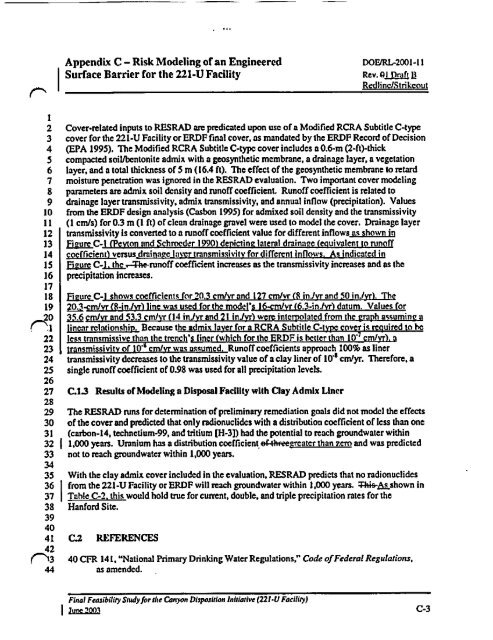View Document Here - Hanford Site
View Document Here - Hanford Site
View Document Here - Hanford Site
You also want an ePaper? Increase the reach of your titles
YUMPU automatically turns print PDFs into web optimized ePapers that Google loves.
2<br />
3<br />
4<br />
5<br />
6<br />
7<br />
8<br />
9<br />
10<br />
11<br />
12<br />
13<br />
14<br />
15<br />
16<br />
17<br />
18<br />
19<br />
^20<br />
.r ..1<br />
22<br />
23<br />
24<br />
25<br />
26<br />
27<br />
28<br />
29<br />
30<br />
31<br />
32<br />
33<br />
34<br />
35<br />
36<br />
37<br />
38<br />
39<br />
40<br />
41<br />
42<br />
("^13<br />
44<br />
Appendix C - Risk Modeling of an Engineered DoFARlr2001-11<br />
Surface Barrier for the 221-U Facility Rev. ol raft Q<br />
Redlinc/Strikcout<br />
Cover-rclated inputs to RESRAD are predicated upon use of a Modified RCRA Subtitle C-type<br />
cover for the 221-U Facility or ERDF final cover, as mandated by the ERDF Record of Decision<br />
(EPA 1995). The Modified RCRA Subtitle C-typc cover includes a 0.6-m (2-ft)-thick<br />
compacted soil/bentonite admix with a geosynthetic membrane, a drainage layer, a vegetation<br />
layer, and a total thickness of 5 m(16.4 ft). The effect of the geosynthetic membrane to retard<br />
moisture penetration was ignored in the RESRAD evaluation. Two important cover modeling<br />
parameters are admix soil density and runoff coefficient. Runoff coefficient is related to<br />
drainage layer transmissivity, admix transmissivity, and annual inflow (precipitation). Values<br />
from the ERDF design analysis (Casbon 1995) for admixed soil density and the transmissivity<br />
(1 cmis) for 0.3 m(1 ft) of clean drainage gravel were used to model the cover. Drainage layer<br />
transmissivity is converted to a runoff coefficient value for different inflows as shown in<br />
Fi gure C- thc .-qhrrunoff coefficient increases as the transmissivity increases and as the<br />
precipitation increases.<br />
i u C- 1 shows coefficientc for 20.3 cm/yr and 127 cm/vr ( 8 in./vr and 50 in./yr1. The<br />
26 cm/vr and 53.3 cm/yr ('<br />
linearrelationship. Because<br />
transmissivitv of 10'° cm/vr was assumed. Runoff coefficients approach 100% as liner<br />
transmissivity decreases to the transmissivity value of a clay liner of 10'8 cm/yr. Therefore, a<br />
single runoff coefficient of 0.98 was used for all precipitation levels.<br />
C.1.3 Results of Modeling a Disposal Facility with Clay Admix Liner<br />
The RESRAD runs for determination of preliminary remediation goals did not model the effects<br />
of the cover and predicted that only radionuclides with a distribution coefficient of less than one<br />
(carbon-14, technetium-99, and tritium (H-3]) had the potential to reach groundwater within<br />
( 1,000 years. Uranium has a distribution coefficient.eRikreeereater than zem and was predicted<br />
not to reach groundwater within 1,000 years.<br />
With the clay admix cover included in the evaluation, RESRAD predicts that no radionuclides<br />
from the 221-U Facility or ERDF will reach groundwater within 1,000 years. ^As shown in<br />
Table C-2. this would hold true for current, double, and triple precipitation rates for the<br />
<strong>Hanford</strong> <strong>Site</strong>.<br />
C.2 REFERENCES<br />
40 CFR 141, "National Primary Drinking Water Regulations;' Code of Federal Regulations,<br />
as amended.<br />
Final Feasibility Study for the Canyon Disposition Initiative (221-U Facility)<br />
June 100<br />
C-3

















